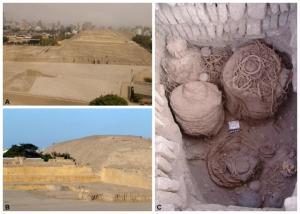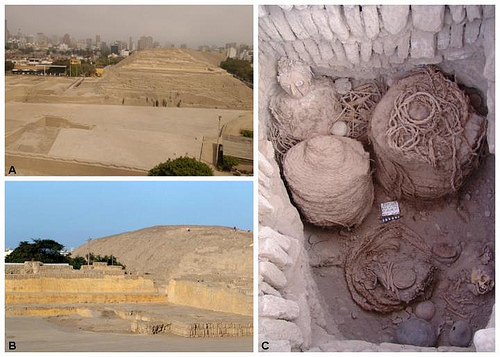
PLOS ONE—The imperial dominance of the ancient Wari Empire at the Huaca Pucllana site in Lima, Peru, was likely not achieved through population replacement, according to a study* published June 1, 2016 in the open-access journal PLOS ONE by Guido Valverde from the University of Adelaide, Australia, and colleagues.
Successive pre-Columbian civilizations existed in the central Andes of South America since the pre-ceramic period 5.5 kya, and ancient empires such as the Wari Empire (600 – 1100 AD) may have been important in shaping the region’s demographic and cultural profiles. To investigate whether Wari dominance in the Peruvian Central Coast was based on population replacement or cultural diffusion, the authors of the present study sequenced the complete mitochondrial genomes of 34 individuals from the Huaca Pucllana archaeological site in Lima, Peru—a location where individuals who lived before, during, and after the Wari Empire—and assessed how this site’s population genetic diversity changed over time.
The researchers found that genetic diversity may only have changed subtly over this period, indicating population continuity over time with only minor genetic impact from Wari imperialism. The subtle genetic diversity shift found at this site may not be representative for the entire Wari territory, and more research is needed to characterize the overall influence of the Wari Empire. Nonetheless, the authors suggest that the Wari Empire may have exerted influence in this area through cultural diffusion rather than by replacement of the pre-existing population.
Guido Valverde adds: “The Huaca Pucllana archaeological site in Peru’s Central Coast represents a unique transect of three successive cultures – Lima, Wari and Ychsma. The site provides the exceptional opportunity to study 1000 years of pre-Inca history, including the impact of the Wari imperialist expansion on Peru’s Central Coast cities.”
_________________________________________
(A-B) This is the view of the Huaca Pucllana archaeological site in Lima, Peru. (C) Shows Wari funerary fardo ‘La Dama de la Máscara’ Credit: Huaca Pucllana research. Conservation and revalorization project
__________________________________________________
Source: Edited from a PLOS ONE news release
_________________________________________
*Valverde G, Barreto Romero MI, Flores Espinoza I, Cooper A, Fehren-Schmitz L, Llamas B, et al. (2016) Ancient DNA Analysis Suggests Negligible Impact of the Wari Empire Expansion in Peru’s Central Coast during the Middle Horizon. PLoS ONE 11(6): e0155508. doi:10.1371/journal.pone.0155508
_______________________________________________________

______________________________________________
Travel and learn with Far Horizons.
____________________________________________
This richly illustrated issue includes the following stories: Recent findings shedding new light on the whereabouts of the remains of Philip of Macedon, father of Alexander the Great; how an archaeologist-sculptor is bringing bones of the dead back to life; archaeologists uncovering town life at the dawn of civilization; an exclusive interview with internationally acclaimed archaeologist James M. Adovasio about what makes the Meadowcroft Rockshelter prominent in the ongoing search for the first Americans; what archaeologists are finding at the site of the ancient city of Gath, the home town of the biblical Philistine giant, Goliath; and how scientists are redrawing the picture of human evolution in Europe. Find it on Amazon.com.









